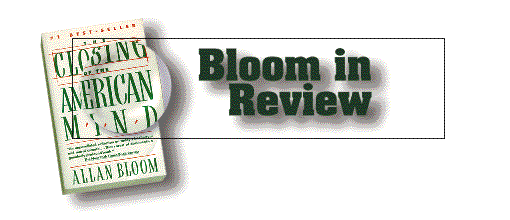

(Continued from previous page)
Despite many obstacles-the weighty topic, plus church services, not to mention hangovers and hook-ups-nearly the whole Saturday audience returned to the Ida Noyes theater for the conference's Sunday-morning session, "Nihilism, American Style?"-an eponymous look at the densest, most thoughtful, and least-read section of Bloom's book.
The final presenter, Robert Pippin, chair of the Committee on Social Thought, presented a focused description, much of it drowned out by the bells of Rockefeller Chapel, of the many provocative concepts attributed to Bloom that were not in his book-the inverse of Bloom's renowned genius for finding universal significance in his own particular experience.
Bloom's real concern, emphasized Pippin, was not about the science or technology or preprofessional faculties. It was not about the massive state multiversities or junior colleges or denominational schools, which have different sets of problems. It was not even about the purported "crisis" in education. It was about our incapacity to discuss or even recognize the peril, "to appreciate what a mess we are in."
Nor was the book, suggested Pippin, despite inspirational sales figures and imposing media attention, terribly influential. The real discussion of the state of the American universities, before and after Bloom, is "much more sociologically oriented," insisted Pippin. The current debate "is focused on such things as the effects of post-war expansion, the explosion of new universities in the '60s, and the much greater preprofessional and career-credentialling ethos created in universities by such expansion; changing social mores; the consequences of a collapsing secondary school system, itself occasioned by changing demographic and employment patterns; the results of competition for the prestige market and so access to those high tuitions; and the financial structure of that completely American institution, the private research university." Names like "Nietzsche and Heidegger, Weber and Freud," said Pippin, "don't often show up in such state-of-higher-education discussions."
Final session chair Nathan Tarcov then opened the floor to global questions, challenges, even harangues, but the crowd seemed a bit talked out. Werner Dannhauser, a former Bloom colleague and now professor of political science at Michigan State, threatened to produce a harangue but concluded instead that, after ten years, he still thought Closing was a pretty good book. The conference's final question came from a man near the back, wearing a camel's hair coat, thick glasses, balding. After three days of discussion, he said, he had no better sense of what direction to take than at the beginning. Without a sense of where we are, he asked, "How can we know where we are going?"
In a sense, that question had been a starting point for Bloom. His take on where America's students were-and where they were going-ignited a firestorm in the academy. If, as Robert Pippin suggests, he was off target when it came to knowing the direction the debate would take, he was dead on in his ability to bring, and inspire others to bring, passion to their arguments. Which may be why, ten years later, the questions raised in The Closing of the American Mind remain entirely open.
Go to:
- INVESTIGATIONS
- CHICAGO JOURNAL
- LETTERS
- CHICAGOPHILE
- Feature story: "Clean-up hitter"
- Feature story: "Waving the Chicago flag"
- Feature story: "Between two Worlds"
- Feature
story: "Bloom in review"
- CLASS NEWS, including ALUMNI AWARDS
- DEATHS
- BOOKS BY ALUMNI
- IN THE CLUBS
Return to August 1997 Table of Contents